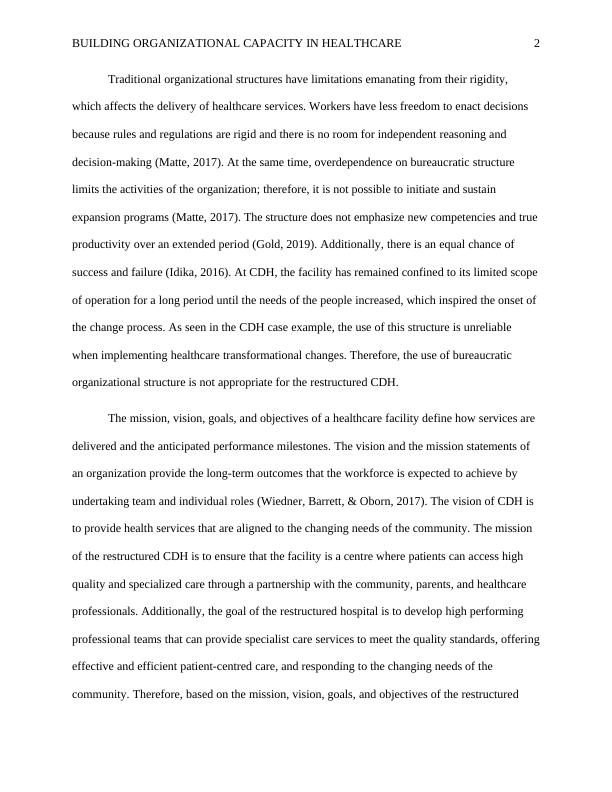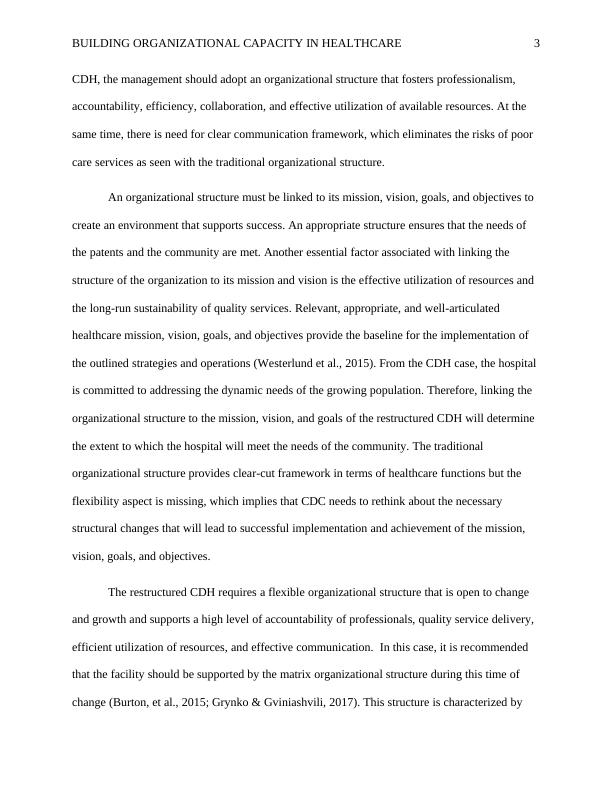BUILDING ORGANIZATIONAL CAPACITY IN HEALTHCARE
Critically analyze and discuss the statement that one particular leadership style cannot be the only model followed in healthcare organizations.
10 Pages2633 Words18 Views
Added on 2022-08-29
BUILDING ORGANIZATIONAL CAPACITY IN HEALTHCARE
Critically analyze and discuss the statement that one particular leadership style cannot be the only model followed in healthcare organizations.
Added on 2022-08-29
ShareRelated Documents
Running head: BUILDING ORGANIZATIONAL CAPACITY IN HEALTHCARE 1
Building Organizational Capacity in Healthcare
The structure of a healthcare organization determines how its operations are undertaken.
Effective and flexible structures guarantee the expansion of the services offered by a healthcare
facility. The use an organizational structure that supports the mission, vision, objectives, and
goals of a healthcare organizations is important (Gary & Marles, n.d). The current analysis is
based on a case study of Chifley District Hospital (CDH), which is currently using a traditional
and bureaucratic organizational structure. This essay provides the advantages and limitations of
the current bureaucratic organizational structure at CDH. The essay also addresses the
importance of CDH’s mission, vision, goals, and objectives and how they relate to the
organizational structure. Finally, it recommends the use of a matrix organizational structure.
A traditional organizational structure guarantees the centralization of authority.
Healthcare facilities that adopt a bureaucratic structure are assured of limited conflicts
originating from authority-related contentions. The administration of activities and programs is
displayed and understood by all workers (Gold, 2019). For example, nurses and other
practitioners are aware of their roles and jurisdictions as well as who they report to? their leaders
across departments since issues of leadership are clear (reference). Once the goal is set and the
resources allocated, rules and regulations define the activities and processes to be followed to
achieve the set objectives (Idika, 2016). As seen in CDH, the organization was able to meet the
needs of the people before a change in the population structure of the community took place.
Therefore, through a bureaucratic system, healthcare facilities are founded on clear-cut rules and
regulations. Additionally, there is a clear communication model, which is essential in healthcare
setting.
Building Organizational Capacity in Healthcare
The structure of a healthcare organization determines how its operations are undertaken.
Effective and flexible structures guarantee the expansion of the services offered by a healthcare
facility. The use an organizational structure that supports the mission, vision, objectives, and
goals of a healthcare organizations is important (Gary & Marles, n.d). The current analysis is
based on a case study of Chifley District Hospital (CDH), which is currently using a traditional
and bureaucratic organizational structure. This essay provides the advantages and limitations of
the current bureaucratic organizational structure at CDH. The essay also addresses the
importance of CDH’s mission, vision, goals, and objectives and how they relate to the
organizational structure. Finally, it recommends the use of a matrix organizational structure.
A traditional organizational structure guarantees the centralization of authority.
Healthcare facilities that adopt a bureaucratic structure are assured of limited conflicts
originating from authority-related contentions. The administration of activities and programs is
displayed and understood by all workers (Gold, 2019). For example, nurses and other
practitioners are aware of their roles and jurisdictions as well as who they report to? their leaders
across departments since issues of leadership are clear (reference). Once the goal is set and the
resources allocated, rules and regulations define the activities and processes to be followed to
achieve the set objectives (Idika, 2016). As seen in CDH, the organization was able to meet the
needs of the people before a change in the population structure of the community took place.
Therefore, through a bureaucratic system, healthcare facilities are founded on clear-cut rules and
regulations. Additionally, there is a clear communication model, which is essential in healthcare
setting.

BUILDING ORGANIZATIONAL CAPACITY IN HEALTHCARE 2
Traditional organizational structures have limitations emanating from their rigidity,
which affects the delivery of healthcare services. Workers have less freedom to enact decisions
because rules and regulations are rigid and there is no room for independent reasoning and
decision-making (Matte, 2017). At the same time, overdependence on bureaucratic structure
limits the activities of the organization; therefore, it is not possible to initiate and sustain
expansion programs (Matte, 2017). The structure does not emphasize new competencies and true
productivity over an extended period (Gold, 2019). Additionally, there is an equal chance of
success and failure (Idika, 2016). At CDH, the facility has remained confined to its limited scope
of operation for a long period until the needs of the people increased, which inspired the onset of
the change process. As seen in the CDH case example, the use of this structure is unreliable
when implementing healthcare transformational changes. Therefore, the use of bureaucratic
organizational structure is not appropriate for the restructured CDH.
The mission, vision, goals, and objectives of a healthcare facility define how services are
delivered and the anticipated performance milestones. The vision and the mission statements of
an organization provide the long-term outcomes that the workforce is expected to achieve by
undertaking team and individual roles (Wiedner, Barrett, & Oborn, 2017). The vision of CDH is
to provide health services that are aligned to the changing needs of the community. The mission
of the restructured CDH is to ensure that the facility is a centre where patients can access high
quality and specialized care through a partnership with the community, parents, and healthcare
professionals. Additionally, the goal of the restructured hospital is to develop high performing
professional teams that can provide specialist care services to meet the quality standards, offering
effective and efficient patient-centred care, and responding to the changing needs of the
community. Therefore, based on the mission, vision, goals, and objectives of the restructured
Traditional organizational structures have limitations emanating from their rigidity,
which affects the delivery of healthcare services. Workers have less freedom to enact decisions
because rules and regulations are rigid and there is no room for independent reasoning and
decision-making (Matte, 2017). At the same time, overdependence on bureaucratic structure
limits the activities of the organization; therefore, it is not possible to initiate and sustain
expansion programs (Matte, 2017). The structure does not emphasize new competencies and true
productivity over an extended period (Gold, 2019). Additionally, there is an equal chance of
success and failure (Idika, 2016). At CDH, the facility has remained confined to its limited scope
of operation for a long period until the needs of the people increased, which inspired the onset of
the change process. As seen in the CDH case example, the use of this structure is unreliable
when implementing healthcare transformational changes. Therefore, the use of bureaucratic
organizational structure is not appropriate for the restructured CDH.
The mission, vision, goals, and objectives of a healthcare facility define how services are
delivered and the anticipated performance milestones. The vision and the mission statements of
an organization provide the long-term outcomes that the workforce is expected to achieve by
undertaking team and individual roles (Wiedner, Barrett, & Oborn, 2017). The vision of CDH is
to provide health services that are aligned to the changing needs of the community. The mission
of the restructured CDH is to ensure that the facility is a centre where patients can access high
quality and specialized care through a partnership with the community, parents, and healthcare
professionals. Additionally, the goal of the restructured hospital is to develop high performing
professional teams that can provide specialist care services to meet the quality standards, offering
effective and efficient patient-centred care, and responding to the changing needs of the
community. Therefore, based on the mission, vision, goals, and objectives of the restructured

BUILDING ORGANIZATIONAL CAPACITY IN HEALTHCARE 3
CDH, the management should adopt an organizational structure that fosters professionalism,
accountability, efficiency, collaboration, and effective utilization of available resources. At the
same time, there is need for clear communication framework, which eliminates the risks of poor
care services as seen with the traditional organizational structure.
An organizational structure must be linked to its mission, vision, goals, and objectives to
create an environment that supports success. An appropriate structure ensures that the needs of
the patents and the community are met. Another essential factor associated with linking the
structure of the organization to its mission and vision is the effective utilization of resources and
the long-run sustainability of quality services. Relevant, appropriate, and well-articulated
healthcare mission, vision, goals, and objectives provide the baseline for the implementation of
the outlined strategies and operations (Westerlund et al., 2015). From the CDH case, the hospital
is committed to addressing the dynamic needs of the growing population. Therefore, linking the
organizational structure to the mission, vision, and goals of the restructured CDH will determine
the extent to which the hospital will meet the needs of the community. The traditional
organizational structure provides clear-cut framework in terms of healthcare functions but the
flexibility aspect is missing, which implies that CDC needs to rethink about the necessary
structural changes that will lead to successful implementation and achievement of the mission,
vision, goals, and objectives.
The restructured CDH requires a flexible organizational structure that is open to change
and growth and supports a high level of accountability of professionals, quality service delivery,
efficient utilization of resources, and effective communication. In this case, it is recommended
that the facility should be supported by the matrix organizational structure during this time of
change (Burton, et al., 2015; Grуnko & Gviniashvili, 2017). This structure is characterized by
CDH, the management should adopt an organizational structure that fosters professionalism,
accountability, efficiency, collaboration, and effective utilization of available resources. At the
same time, there is need for clear communication framework, which eliminates the risks of poor
care services as seen with the traditional organizational structure.
An organizational structure must be linked to its mission, vision, goals, and objectives to
create an environment that supports success. An appropriate structure ensures that the needs of
the patents and the community are met. Another essential factor associated with linking the
structure of the organization to its mission and vision is the effective utilization of resources and
the long-run sustainability of quality services. Relevant, appropriate, and well-articulated
healthcare mission, vision, goals, and objectives provide the baseline for the implementation of
the outlined strategies and operations (Westerlund et al., 2015). From the CDH case, the hospital
is committed to addressing the dynamic needs of the growing population. Therefore, linking the
organizational structure to the mission, vision, and goals of the restructured CDH will determine
the extent to which the hospital will meet the needs of the community. The traditional
organizational structure provides clear-cut framework in terms of healthcare functions but the
flexibility aspect is missing, which implies that CDC needs to rethink about the necessary
structural changes that will lead to successful implementation and achievement of the mission,
vision, goals, and objectives.
The restructured CDH requires a flexible organizational structure that is open to change
and growth and supports a high level of accountability of professionals, quality service delivery,
efficient utilization of resources, and effective communication. In this case, it is recommended
that the facility should be supported by the matrix organizational structure during this time of
change (Burton, et al., 2015; Grуnko & Gviniashvili, 2017). This structure is characterized by

End of preview
Want to access all the pages? Upload your documents or become a member.
Related Documents
Building Organizational Capacity in Healthcarelg...
|10
|2314
|85
Building Organizational Capacity in Healthcarelg...
|11
|2480
|37
Building an Organizational Structure for Whitlam Memorial Hospitallg...
|9
|2260
|218
Building an Organizational Structure for Whitlam Memorial Hospitallg...
|9
|2258
|314
Foundations Of Management | Report - MGMT101lg...
|5
|720
|108
Organisational Capacity in Health Care - PDFlg...
|9
|2204
|131
